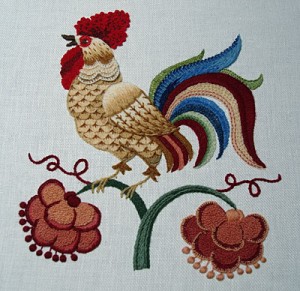Types of Hand Embroidery on Needle ‘n Thread
Crewel Embroidery
 |
In the historical sense, crewel embroidery is simply embroidery done with wool threads. Crewel work has a rich history, stretching at least as far back as the early Medieval period, with one of the most extant historical examples being the Bayeux Tapestry.
Crewel work enjoyed popularity in the Jacobean area, with elaborate designs of stylized flowers, birds, and beasts being worked in wool on household goods and even clothing. Crewel work, however, should not be confused with “Jacobean embroidery.” Jacobean is a style of design and can be worked in any medium, while crewel work is specifically embroidery worked in wool.
Off and on, crewel work has resurfaced in popularity. In the 1970’s, it enjoyed great popularity. Today, crewel work is enjoying another revival in popularity, as the plethora of new books devoted to crewel work attests.
In crewel work today, we see a variation from traditional crewel in the addition of other types of threads being integrated (or even replacing altogether) the traditionally used wool. Often today, crewel work designers will incorporate silk threads, cottons, and blends in their crewel designs. Technically, if the wool isn’t there, is it really crewel work? Or has it morphed into surface embroidery?
Related posts:






